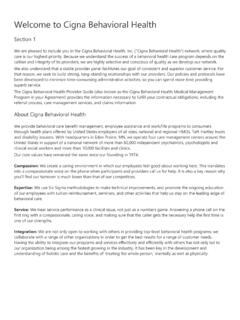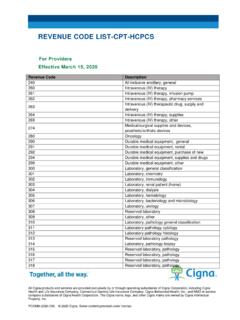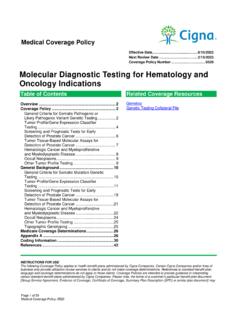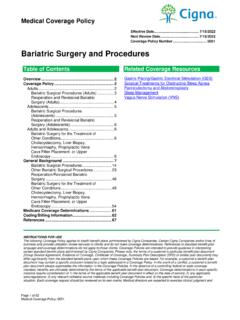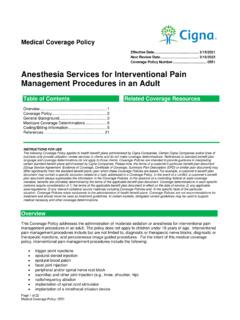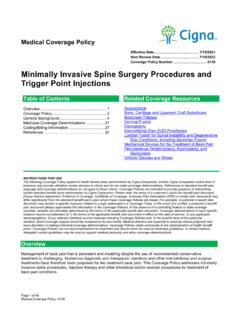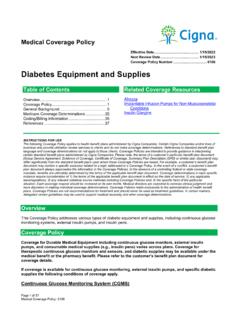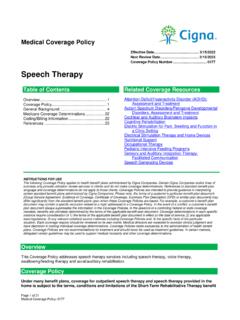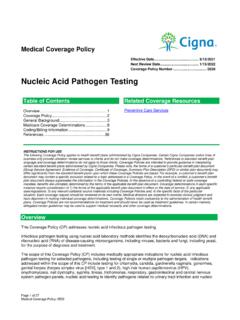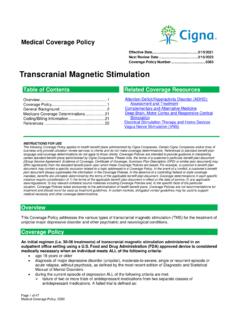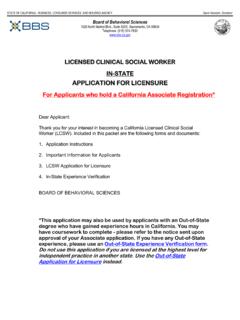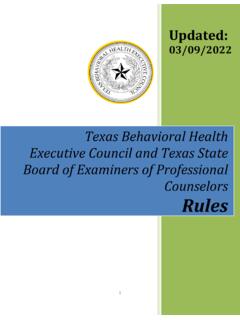Transcription of Intensive Behavioral Interventions - Cigna
1 Medical Coverage Policy Effective Date ..12/15/2019. Next Review Coverage Policy Number .. 0499. Intensive Behavioral Interventions Table of Contents Related Coverage Resources Overview .. 1 Attention-Deficit/Hyperactivity Disorder (ADHD): Coverage Assessment and Treatment General Background ..3 Autism Spectrum Disorders/Pervasive Developmental Coding/Billing Information ..10 Disorders: Assessment and Treatment References ..11. INSTRUCTIONS FOR USE. The following Coverage Policy applies to health benefit plans administered by Cigna Companies. Certain Cigna Companies and/or lines of business only provide utilization review services to clients and do not make coverage determinations.
2 References to standard benefit plan language and coverage determinations do not apply to those clients. Coverage Policies are intended to provide guidance in interpreting certain standard benefit plans administered by Cigna Companies. Please note, the terms of a customer's particular benefit plan document [Group Service Agreement, Evidence of Coverage, Certificate of Coverage, Summary Plan Description (SPD) or similar plan document] may differ significantly from the standard benefit plans upon which these Coverage Policies are based. For example, a customer's benefit plan document may contain a specific exclusion related to a topic addressed in a Coverage Policy.
3 In the event of a conflict, a customer's benefit plan document always supersedes the information in the Coverage Policies. In the absence of a controlling federal or state coverage mandate, benefits are ultimately determined by the terms of the applicable benefit plan document. Coverage determinations in each specific instance require consideration of 1) the terms of the applicable benefit plan document in effect on the date of service; 2) any applicable laws/regulations; 3) any relevant collateral source materials including Coverage Policies and; 4) the specific facts of the particular situation.
4 Coverage Policies relate exclusively to the administration of health benefit plans. Coverage Policies are not recommendations for treatment and should never be used as treatment guidelines. In certain markets, delegated vendor guidelines may be used to support medical necessity and other coverage determinations. Overview This Coverage Policy addresses Intensive Behavioral Interventions for treatment of autism spectrum disorders. Coverage Policy Some states mandate coverage of Intensive Behavioral Interventions and/or treatment of autism spectrum disorders (ASD) for benefit plans regulated under state law.
5 For example, New York law requires regulated benefit plans to provide coverage for the screening, diagnosis and treatment of ASD, including applied Behavioral analysis. Please refer to the applicable benefit plan document to determine terms, conditions and limitations of coverage. Medically Necessary Criteria for Assessment for Applied Behavior Analysis (ABA). An assessment for applied behavior analysis (ABA) is considered medically necessary when ALL the following criteria are met: Page 1 of 16. Medical Coverage Policy: 0499. a diagnosis of Autism Spectrum Disorder (ASD) per the diagnostic criteria for Autism Spectrum Disorder from Diagnostic and Statistical Manual of Mental Disorders, Fifth Edition (DSM-5).
6 The assessment is being performed by a Board Certified Behavior Analyst (BCBA) or a mental health clinician licensed to practice independently who will be providing supervision/treatment planning for the individual the assessment includes the administration of a reliable and valid standardized assessment tool ( , Verbal Behavior Milestones Assessment and Placement Program [VB-MAPP], Vineland Adaptive Scales, Assessment of Basic Language and Learning Skills [ABLLS-R], Autism Treatment Evaluation Checklist (ATEC), PDD Behavior Inventory (PDDBI), Social Responsiveness Scale, Second Edition (SRS-2), Adaptive Behavior Assessment System - Third Edition (ABAS-3), Promoting the Emergence of Advanced Knowledge (PEAK), Social Skills Improvement System SSIS Rating Scales (SSIS Rating Scales) that measures the domains included in the diagnostic criteria for Autism Spectrum Disorder Criteria for Initiation of Treatment with ABA.)
7 ABA is considered medically necessary when ALL the following criteria are met: 1. Diagnosis of Autism Spectrum Disorder (ASD) per the diagnostic criteria for Autism Spectrum Disorder from Diagnostic and Statistical Manual of Mental Disorders, Fifth Edition (DSM-5). 2. Completion of a full and comprehensive ABA assessment including all of the following: A. Assessment of current functioning in the areas impacted by Autism completed by a Board Certified Behavior Analyst (BCBA), or other independently licensed mental health clinician using reliable and valid standardized assessment tools.
8 B. A complete developmental history has been obtained including: o relevant co-morbid conditions o vision and hearing evaluations o current medications C. Consideration of family/caregivers, including language or cultural factors that may impact treatment. D. Evidence from the evaluation that the individual is capable of making Behavioral and cognitive gains. 3. Individualized treatment plan has been developed including specific targeted behaviors/skills for improvement, along with clearly defined, measurable, and realistic goals for improving those behaviors/skills and addresses the following: a) Baseline data has been obtained for all behaviors and skills identified for intervention across all settings ( , home, school, summer camp) where treatment will occur.
9 B) The planned intensity of treatment across all settings reflects the severity of the impairments, goals of treatment, response to treatment and specific individual variables. c) If group treatment is planned, the treatment plan must include clearly defined, measurable goals for the group therapy that are specific to the individual and his/her targeted behaviors/skills. d) Treatment goals are directly related to the core symptoms of ASD as defined by the DSM-5. e) Treatment planning and supervision is performed by a Board Certified Behavior Analyst (BCBA) or a mental health professional that is licensed to practice independently.
10 The amount of supervision and treatment planning must be consistent with the generally accepted practice standard of one to two hours per ten hours of direct treatment. f) Direct supervision (BCBA face-to-face with the individual and either the Registered Behavior Technician [RBT] or the Board Certified Assistant Behavior Analyst [BCaBA]) delivering the direct treatment) time accounts for 50% or more of case supervision. g) The treatment plan includes a measurable parent/caregiver (including teachers and other stakeholders as appropriate) goals to train them in the basic Behavioral principles of ABA.
